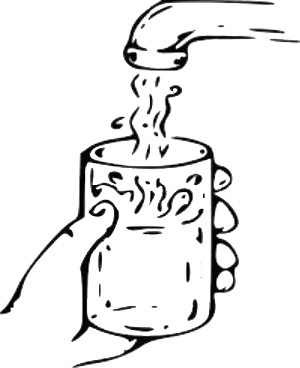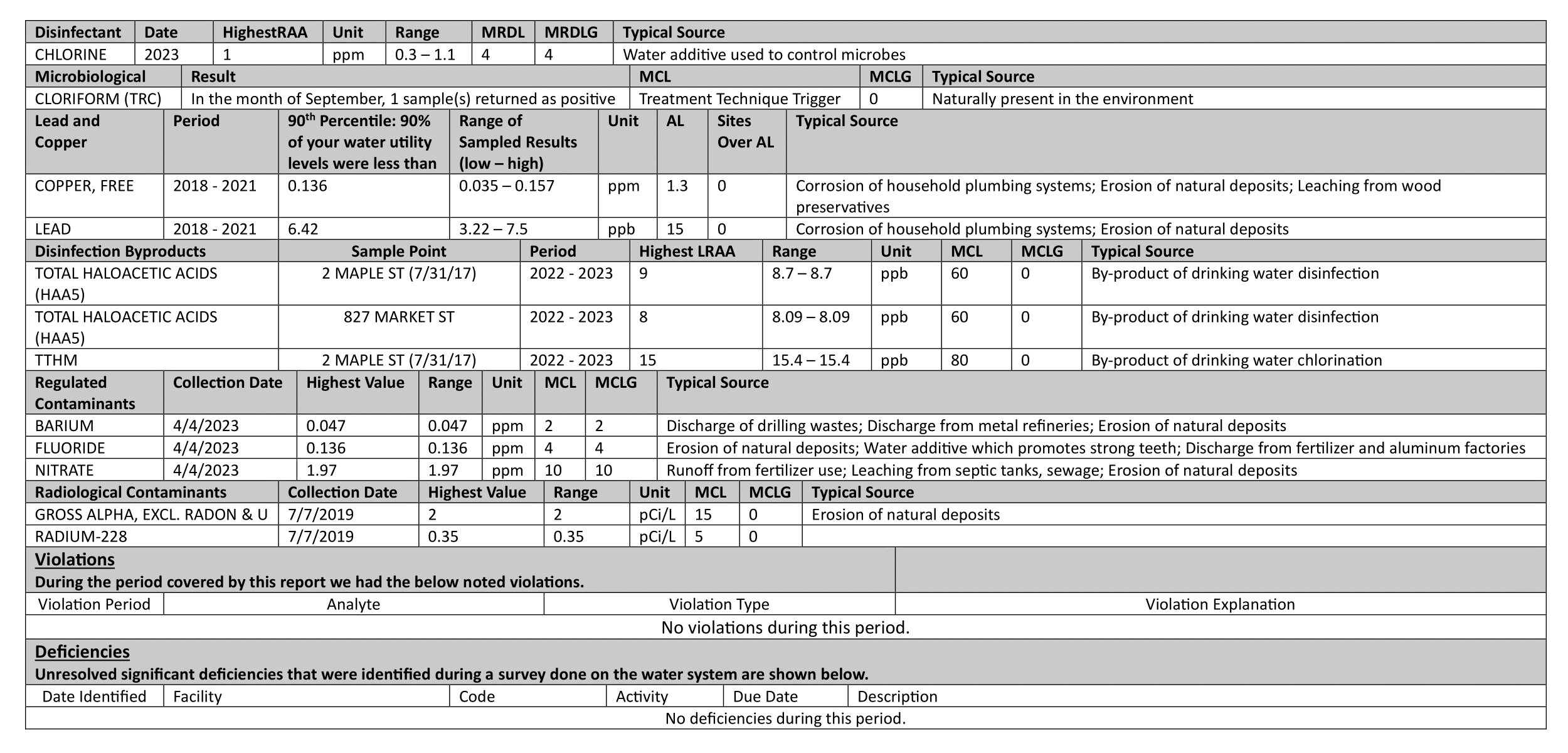2023 Annual Drinking Water Quality Report
Liberty Waterworks
Liberty, Indiana
PWSID IN5281001
The Town of Liberty is pleased to present this year's Annual Drinking Water Quality Report. This report is designed to keep you informed about the quality of your drinking water from January 1st to December 31st 2023. Our goal is and always have been, to provide you, the customer, with a safe and dependable supply of drinking water. We are pleased to report that our drinking water is safe and meets all federal and state requirements.
The source of Liberty's drinking water is groundwater produced from two active wells located 4 miles west of Liberty on S.R. 44. This well field is completed in the Outwash Aquifer adjacent to the East Fork Whitewater River.
Sources of drinking water (both tap and bottled water) include rivers, lakes, streams, ponds, reservoirs, springs, and wells. As water travels over the surface of the land or through the ground, it dissolves naturally occurring minerals and in some cases, radioactive material, and can pick up substances resulting from the presence of animals or from human activity.

Some people may be more vulnerable to contaminants in drinking water than the general population. Immuno-compromised persons such as persons with cancer undergoing chemotherapy, persons who have undergone organ transplants, people with HIV/AIDS or other immune system disorder, some elderly, and infants can be particularly at risk from infections. These people should seek advice about drinking water from their healthcare providers. EPA/CDC guidelines on appropriate means to lessen the risk of infection by cryptosporidium and other microbiological contaminants are available from the Safe Drinking Water Hotline (800-426-4791).
We want our valued customers to be informed about their water utility. If you have any questions about this report or concerning your water utility, please contact Dylan Ripberger or the Clerk-Treasurer at 765-458-5823, or stop by at our office at 1 S. Fairground St, Liberty, IN 47353. If you want to learn or, you are welcome to attend any of our regularly scheduled Town Council meetings, held at 6p.m. on the First and Third Monday of each month.
Liberty Waterworks routinely monitors for contaminants in your drinking water according to all federal and state laws and 9 contaminants. The following table provides the results for only those contaminants that were detected as part of our 2019-2023 monitoring.
We are dedicated to provide top quality water to every tap. We ask that all our customers help us protect our water sources, which are the heart of our community, our way of life, and our children’s future.
The Town of Liberty has implemented the Well-head Protection Plan. Copies of the Plan and educational material are available for viewing at the Town Hall.
Contaminants that may be present in source water include:
- Microbial Contaminants such as viruses and bacteria, which may come from sewage treatment plants, septic systems, agricultural livestock operations, and wildlife.
- Inorganic contaminants such as salts and metals, which can be naturally-occurring or result from urban storm water runoff, industrial or domestic wastewater discharges, oil and gas production, mining, or farming.
- Pesticides and herbicides, which may come from a variety of sources such as agriculture, storm water runoff, and residential use.
- Organic Chemicals, including synthetic and volatile organic chemicals, which are byproducts of industrial processes and petroleum production and can also come from gas stations, urban storm water run-off, and septic systems.
- Radioactive materials, which can be naturally occurring or the result of oil and gas production and mining activities.
If present, elevated levels of lead can cause serious health problems, especially for pregnant women and young children. Lead in drinking water is primarily from materials and components associated with service lines and home plumbing. The Town of Liberty is responsible for providing high quality drinking water, but cannot control the variety of material used in plumbing components. When your water has been sitting for several hours, you can minimize the potential for lead exposure by flushing your tap for 30 seconds to 2 minutes before using water for drinking or cooking. If you are concerned about lead in your water, you may wish to have your water tested. Information on lead in drinking water, testing methods, and steps you can take to minimize exposure is available from the Safe Drinking Water Hotline at https://www.epa.gov/safewater/lead
Drinking water, including bottled water, may reasonably be expected to contain at least small amounts of some contaminants. The presence of contaminants does not necessarily indicate that the water poses a health risk. More information about contaminants and potential health effects can be obtained by calling the Environmental Protection Agency’s Safe Drinking Water Hotline at 800-426-4791
Average Water Quality Data For 2023
Disinfectant | Date | HighestRAA | Unit | Range | MRDL | MRDLG | Typical Source | |
CHLORINE | 2023 | 1 | ppm | 0.3 – 1.1 | 4 | 4 | Water additive used to control microbes | |
Microbiological | Result | MCL | MCLG | Typical Source | ||||
COLIFORM (TRC) | In the month of September, 1 sample(s) returned as positive | Treatment Technique Trigger | 0 | Naturally present in the environment | ||||
Lead and Copper | Period | 90th Percentile: 90% of your water utility levels were less than | Range of Sampled Results (low – high) | Unit | AL | Sites Over AL | Typical Source | |
COPPER, FREE | 2018 - 2021 | 0.136 | 0.035 – 0.157 | ppm | 1.3 | 0 | Corrosion of household plumbing systems; Erosion of natural deposits; Leaching from wood preservatives | |
LEAD | 2018 - 2021 | 6.42 | 3.22 – 7.5 | ppb | 15 | 0 | Corrosion of household plumbing systems; Erosion of natural deposits | |
Disinfection Byproducts | Sample Point | Period | Highest LRAA | Range | Unit | MCL | MCLG | Typical Source |
TOTAL HALOACETIC ACIDS (HAA5) | 2 MAPLE ST (7/31/17) | 2022 - 2023 | 9 | 8.7 – 8.7 | ppb | 60 | 0 | By-product of drinking water disinfection |
TOTAL HALOACETIC ACIDS (HAA5) | 827 MARKET ST | 2022 - 2023 | 8 | 8.09 – 8.09 | ppb | 60 | 0 | By-product of drinking water disinfection |
TTHM | 2 MAPLE ST (7/31/17) | 2022 - 2023 | 15 | 15.4 – 15.4 | ppb | 80 | 0 | By-product of drinking water chlorination |
Regulated Contaminants | Collection Date | Highest Value | Range | Unit | MCL | MCLG | Typical Source | |
BARIUM | 4/4/2023 | 0.047 | 0.047 | ppm | 2 | 2 | Discharge of drilling wastes; Discharge from metal refineries; Erosion of natural deposits | |
FLUORIDE | 4/4/2023 | 0.136 | 0.136 | ppm | 4 | 4 | Erosion of natural deposits; Water additive which promotes strong teeth; Discharge from fertilizer and aluminum factories | |
NITRATE | 4/4/2023 | 1.97 | 1.97 | ppm | 10 | 10 | Runoff from fertilizer use; Leaching from septic tanks, sewage; Erosion of natural deposits | |
Radiological Contaminants | Collection Date | Highest Value | Range | Unit | MCL | MCLG | Typical Source | |
GROSS ALPHA, EXCL. RADON & U | 7/7/2019 | 2 | 2 | pCi/L | 15 | 0 | Erosion of natural deposits | |
RADIUM-228 | 7/7/2019 | 0.35 | 0.35 | pCi/L | 5 | 0 | ||
Violations During the period covered by this report we had the below noted violations. | ||||||||
Violation Period | Analyte | Violation Type | Violation Explanation | |||||
No violations during this period. | ||||||||
Deficiencies Unresolved significant deficiencies that were identified during a survey done on the water system are shown below. | ||||||||
Date Identified | Facility | Code | Activity | Due Date | Description | |||
No deficiencies during this period. | ||||||||
Our water system tested a minimum of 2 samples per month in accordance with the Total Coliform Rule for microbiological contaminants. With the microbiological samples collected, the water system collects disinfectant residuals to ensure control of microbial growth.
In the tables above, you will find many terms and abbreviations you might not be familiar with. To help you better understand these terms, we’ve provided the following definitions:
Action Level (AL): The concentration of a contaminant which, if exceeded, triggers treatment or other requirements which a water system must follow.
Action Level Goal (ALG): The level of a contaminant in drinking water below which there is no reason known or expected risk to health. ALGs allow for margin of safety.
Level 1 Assessment: A Level 1 assessment is a study of the water system to identify potential problems and determine (if possible) why total coliform bacteria have been found in our water system.
Level 2 Assessment: A Level 2 assessment is a very detailed study of the water system to identify potential problems and determine (if possible) why an E. coli MCL violation has occurred and/or why total coliform bacteria have been found in our water system on multiple occasions.
Maximum Contaminant Level (MCL): The highest level of a contaminant that is allowed in drinking water. MCLs are set as close to the MCLGs as feasible using the best available treatment technology.
Maximum Containment Level Goal (MCLG): The level of a contaminant in drinking water below which there is no known or expected risk to health. MCLGs allow for margin of safety.
Maximum Residual Disinfectant Level (MRDL): The highest level of disinfectant allowed in drinking water. There is convincing evidence that addition of disinfectant is necessary for control of microbial contaminants.
Maximum Residual Disinfectant Level Goal (MRDLG): The level of a drinking water disinfectant below which there is no known or expected risk to health. MRDLGs do not reflect the benefits of the use of disinfectants to control microbial contaminants.
Treatment Technique (TT): A required process intended to reduce the level of a contaminant in drinking water.
Variances and Exemptions: State or EPA permission not to meet an MCL or Treatment Technique under certain conditions.
AVG: Average – Regulatory compliance with some MCLs are based on running annual average of monthly samples.
LRAA: Locational Running Annual Average.
mrem: Millirems per year (a measurement of radiation absorbed by the body).
ppb: Micrograms per liter (ug/L) or Parts Per Billion – or one ounce in 7,350,000 gallons of water.
ppm: Milligrams per liter (mg/L) or Parts Per Million – or once ounce in 7,350 gallons of water.
pCi/L: Picocuries Per Liter is a measurement of the radioactivity in water.
na: Not applicable.
